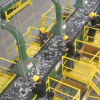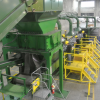Expired IT Assets as a profit centre
Following the recent announcement by U.S. Micro that it is to become the exclusive provider of ITAD services to Macquarie Equipment Finance’s (MEF) North American customers, I spoke with Herb Biggers, Chairman of the Board, and Jim Kegley, Founder, President and CEO of U.S. Micro Corporation to understand a little more detail about the relationship between the two organisations.
So what new and exciting developments have there been since you opened the Las Vegas facility 18 months ago?
Jim: Well firstly we have increased the size of our shredder threefold, but more importantly, de-manufacturing is becoming an important process for us. Guidance from the OEMs and technological improvements has allowed us to recover the intrinsic parts such as the motherboards and there is a large market for their re-use.
Herb: We feel that this is a game changing ability in the market these days. De-manufacturing is going to alter the complexion of disposition services as the benefits are increasingly recognised and the technology improves. In fact of the circa 10% of devices we receive that we are unable to refurbish and resell, 65% are demanufactured (requiring less energy resources) and the remainder shredded.
The agreement seems to include an element of acquisition, part joint venture opportunity and part service provider. Can you explain exactly what the status of the relationship is?
Jim: U.S. Micro has been through a rigorous tender process managed by MEF. After several months of extensive considerations and negotiation, U.S. Micro have been awarded the exclusive partnership to deliver ITAD services to MEF and their customers in North America.
Herb: As part of that award, Macquarie’s Texas facility was acquired by U.S. Micro. This is allowing U.S. Micro to expand its services and capability beyond its traditional capability into the arena of mid-range and telecoms equipment disposal, a speciality that exists in the Texas facility.
So how are U.S. Micro and MEF strategies being aligned through the agreement?
Jim: The two organisations have desires in the North American market that are fully complementary. U.S. Micro has been looking to expand its services and this will be achieved through the enterprise capability of the new Texas facility. The technical expertise in the enterprise space that has been acquired is a great additional offering for U.S. Micro’s existing customers.
Herb: The MEF sales force can help expand U.S. Micro’s reach in to MEF’s customer-base. Let’s not forget that the leasing customers have owned hardware which they are now able to dispose of through U.S. Micro. The sales representatives for MEF now have the opportunity to offer U.S. Micro’s disposition, remarketing and de-manufacture services as part of their customer engagement model.
What would you say is the single most important differentiator that MEF saw in U.S. Micro?
Jim: U.S. Micro’s onsite services for data management and sanitisation is something that customers in North America are requesting in ever greater numbers. Additionally, MEF recognised how effective U.S. Micro is at refurbishing and reselling IT equipment, which is the highest form of recycling. We re-sell about 90 percent of the assets we process. This also raises the value of MEF customer assets.
So how long before the Dallas facility is fully flying the U.S. Micro flag
Jim: It’s already up! The facility has been fully integrated into the U.S. Micro portfolio since the 1st February 2013. We are already offering the enterprise and telecoms services to our existing customers.
Herb: Both MEF and U.S. Micro recognised the importance of that acquisition so we both wanted to make sure that we hit the ground running.
Finally can you just explain in a little more detail what demanufacturing means to U.S. Micro?
Jim: Upon arrival at a U.S. Micro facility, IT assets are evaluated to determine the appropriate disposition method. Approximately 90 percent of IT equipment received can be refurbished and sold or donated for extended use. The remaining 10 percent is sorted by like assets before being sent to our in-house demanufacturing line. With a PC, each component is stripped down to the core pieces and separated into steel, aluminum, plastic, wiring, circuit boards and more. These commodity pieces are then further sorted by ferrous and non-ferrous metals. Multiple demanufacturing lines are utilized until separation is complete.
Herb: he overall goal with assets is to break down the components so they can be resold into the commodities market or used in remanufacturing. With its ability to demanufacture assets at its own facility, U.S. Micro eliminates the risk associated with downstream processing vendors and fulfills its commitment to a 100 percent no landfill policy.
Images from US Micro facilities, click to enlarge.
About Martin Chalkley
Martin is a specialist in optimising IT costs and IT Sourcing Strategy. Martin has driven collaborative relationships with IT and Telco Vendors and is co-author of the IACCM course on Supplier Relationship Management.
Martin is the owner at Consultandomi Ltd, SRM Programme Manager at the IACCM and an Associate Consultant at Gartner.



